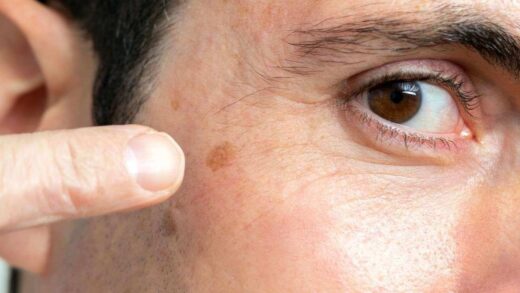Sun-kissed skin may symbolize health and vitality, but for many men, prolonged sun exposure leads to some less desirable sunspots, or solar lentigines. These brown or tan patches may seem like a minor cosmetic issue at first, but if left unaddressed, they can deepen in color, spread, and in some cases, signal more serious skin conditions.
In this article, we’ll answer common questions about sunspots in men: are they permanent, how to prevent them, what products help, and when you should seek professional evaluation.

Are Sunspots Permanent in Men?
Sunspots are not necessarily permanent, but they don’t fade on their own quickly either.
- Superficial sunspots may lighten over time with proper skincare and sun protection.
- Deeper pigmentation often persists without treatment.
- Repeated sun exposure can darken and increase the number of spots, making reversal more difficult.
With consistent care and the right products, many sunspots can be reduced or even eliminated. For stubborn cases, dermatological treatments offer faster and more dramatic results.
Where Do Sunspots Commonly Appear on Men?
Unlike women who often focus heavily on facial skincare men tend to apply sunscreen less consistently. This leads to frequent sun damage in exposed areas.
Most common areas for sunspots in men include:
- Face: Especially forehead, nose, and cheeks
- Scalp: Particularly in balding men
- Neck and shoulders
- Arms and hands
- Upper chest (in men who wear open collars)
These areas are typically left unprotected during outdoor activities, sports, driving, or simply walking in the sun.
What Causes Sunspots in Men?
Sunspots are caused by overproduction of melanin, the pigment responsible for skin color. When your skin is exposed to UV radiation (especially UVA rays), melanocytes become overactive and cluster, forming flat, discolored patches.
Men are more prone to sunspots when:
- They spend long hours outdoors without SPF
- They do not moisturize or exfoliate regularly
- They have fair skin or light eyes
- They use photosensitizing medications (e.g., antibiotics, diuretics)
- They smoke or drink excessively, which accelerates skin aging
What SPF Should Men Use to Prevent Sunspots?
SPF (Sun Protection Factor) is your first line of defense. For effective prevention:
- Use SPF 50 broad-spectrum sunscreen daily on all exposed skin
- Choose products with UVA + UVB protection
- Reapply every 2 hours, especially if sweating or swimming
- Opt for non-greasy, fast-absorbing formulas to encourage daily use
Tip: For bald or thinning scalps, use a spray sunscreen or wear a UV-blocking cap.
What Products Help Men Prevent or Treat Sunspots?
Men’s skincare doesn’t have to be complicated. Start with these three essentials:
1. Daily SPF Moisturizer (SPF 30–50)
- Look for lightweight, oil-free formulas
- Apply every morning even on cloudy days
2. Brightening Serums
- Containing niacinamide, vitamin C, azelaic acid, or licorice extract
- Use in the morning under SPF or at night before moisturizer
3. Night Creams with Mild Exfoliants
- Look for AHAs (glycolic/lactic acid) or retinol
- Promote skin renewal and help fade existing spots
Which Creams Are Recommended for Treating Sunspots in Men?
For over-the-counter care, dermatologists often recommend:
- Melanin-inhibiting creams with ingredients like:
- Hydroquinone (short-term use under medical supervision)
- Kojic acid
- Tranexamic acid
- Hydroquinone (short-term use under medical supervision)
- Prescription-strength retinoids for advanced cases
- Peptide-based serums for skin renewal
Important: Products must be paired with daily sun protection. Treating dark spots while neglecting SPF will only lead to frustration and wasted time.
Can Sunspots Be Dangerous in Men?
Most sunspots are benign, but any skin discoloration should be monitored for suspicious changes.
See a dermatologist if a spot:
- Darkens suddenly or bleeds
- Develops an irregular shape or border
- Appears raised or changes in texture
- Itches or becomes painful
In some cases, what appears to be a sunspot may be an actinic keratosis (precancerous lesion) or an early-stage melanoma.
Annual skin checks are strongly advised, especially for men with:
- A history of sunburns
- Outdoor occupations
- Light skin and freckles
- Family history of skin cancer
How Can Men Minimize the Risk of Sunspots Year-Round?
- Use sunscreen daily face, neck, scalp, and ears included
- Avoid peak sun hours (10 AM to 4 PM)
- Wear hats and UV-protective sunglasses
- Apply after-sun moisturizers with antioxidants
- Exfoliate gently once or twice a week to encourage skin turnover
- Hydrate and sleep well skin heals best in rest and balance
Expert Dermatology Care for Men’s Skin Health

At Erdem Hospital in Istanbul, we understand that men often ignore early signs of skin damage until they become difficult to reverse. Our specialized dermatology department offers:
- Skin mapping and sun damage assessments
- Personalized treatment for sunspots, pigmentation, and aging signs
- Medical-grade products tailored to men’s skin
- Cosmetic procedures like laser therapy, chemical peels, and microneedling
- Annual skin cancer screenings for preventive care
With over 37 years of medical excellence, Erdem Hospital helps men protect and restore their skin safely, effectively, and confidently.